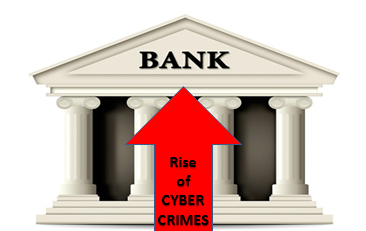In this era
of Digitization, the Banking sector in India has revolutionized itself tremendously.
Banks are now providing faster, efficient, convenient, and better services to
the customers, 24*7 with the help of Information Technology. E-banking services
have made it possible for customers to do transactions within a click! Now
banking services are available anytime, anywhere through ATMs, NEFT/RTGS,
e-wallets etc.
However, the
increase in use of Information technology in the Banking sector, has given rise
to cyber crimes. Banks are more prone to cyber attacks, because in comparison
to other organizations, that is where most amount of money is. Banks are
becoming targets of cyber crimes on a daily basis, with cyber threats coming in
every day, at national and international level. Majority of the times, Cyber
crimes are committed to gain unauthorized access into a user’s account, steal
their personal and sensitive information, and fraudulently transfer money from
one account to the other.
Types of Banking services that are targeted by cyber criminals
Cyber
criminals are working round the clock to come up with newer ways of attacking.
Some of the methods used by them are:
Virus
A computer virus is malicious
code that replicates by copying itself to another program, computer boot
sector, or document and changes how a computer works. The virus requires
someone to knowingly or unknowingly spread the infection without the knowledge
or permission of a user or system administrator.
Worms
A computer worm is a
self-replicating computer program that penetrates an operating system with the
intent of spreading malicious code. Worms utilize networks to send copies of
the original code to other computers, causing harm by consuming bandwidth or possibly
deleting files or sending documents via email.
Spam emails
Email spam, also known
as junk email, is a type of electronic spam where
unsolicited messages are sent by email. Many email spam messages are commercial in
nature but may also contain disguised links that
appear to be for familiar websites but in fact lead to phishing web
sites or sites that are hosting malware. Spam email
may also include malware as scripts or other executable file attachments.
Trojans
Trojan, is any malicious computer
program which is used to hack into a computer by misleading users of its true
intent. Trojans may
allow an attacker to access users' personal information such as banking
information, passwords, or personal identity (IP address).
Ransomware
Ransom-ware is a type of malicious
software that blocks access to the victim's data or threatens to publish or
delete it until a ransom is paid.
Malware
Malware, short for malicious
software, is any software used to disrupt computer or mobile operations, gather
sensitive information, gain access to private computer systems, or display
unwanted advertising.
Vishing
It is the fraudulent practice of
making phone calls or leaving voice messages purporting to be from reputable
companies in order to induce individuals to reveal personal information, such
as bank details and credit card numbers.
Phishing
Phishing is the attempt to obtain
sensitive information such as usernames, passwords, and credit card details
(and, indirectly, money), often for malicious reasons, by disguising as a
trustworthy entity in an electronic communication.
Denial-of-service(DoS)
A denial-of-service attack (DoS
attack) is a cyber-attack where the perpetrator seeks to make a machine or
network resource unavailable to its intended users by temporarily or
indefinitely disrupting services of a host connected to the Internet.
Card Skimming
Card skimming is the act of using
a skimmer to illegally collect data from the magnetic stripe of a credit, debit
or ATM card. This information, copied onto another blank card's magnetic
stripe, is then used by an identity thief to make purchases or withdraw cash in
the name of the actual account holder.
Hacking
Hacking means an unauthorized
access made by a person to cracking the systems or an attempt to bypass the
security mechanisms, by hacking the banking sites or accounts of the customers.
Spyware
It is a software by way of which
online banking credentials are stolen and used for fraudulent activities. Most
of the times it is installed through “pop-up” ads.
Credit card fraud
Credit card fraud is committed by
making use of credit/debit card of others for obtaining goods or services. The
threat emerges due to stealing of information like Credit card number, PIN
number,password etc. Hackers use complex techniques like Phishing, Skimming
etc. to gain credit card information from innocent users.
With the
increase in the number of crimes, Banks need to take cyber security more
seriously. The Banks need to seek ways to combat cyber attacks by implementing
cyber security frameworks and systems. The Reserve Bank of India (RBI) has
provided guidelines for Banks on Cyber security framework, Information
Security, Electronic Banking, Technology Risk Management and Cyber Frauds. However,
some Banks are still hesitant to implement necessary security measures. The
Banks are struggling to cope up with the advance in technology and the risks
attached to it. Therefore, the danger of an attack is still omnipresent as cyber crime continues to remain a difficult
challenge for the Banks.



Comments
Post a Comment